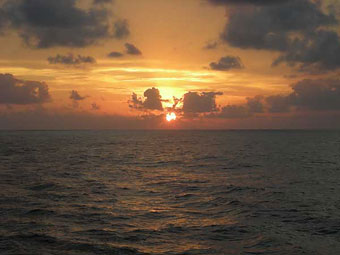

 | |||||||
|
|
Journals 2007/2008Heather Judkins
November 5, 2007 The day began at 0603 as the sun was rising. I am assigned to work with the CTD cast which measures conductivity, temperature, and density for the next few days. It is a large, cylindrical piece of equipment with 12 bottles that collect water samples at a given depth dictated by the scientists. The process begins by using the A-frame (aka a gantry or pulley system) to deploy the CTD into the water. It is lowered to 1000 m and begins taking water samples. There is an oxygen, temperature, and conductivity sensor which records information to a computer program in the dry lab (aka computer lab). As the team raises the CTD, they begin to "fire" the bottles. This closes one of the bottles at a given depth through a triggering device on the equipment from the surface. The team slowly raises the CTD and takes 12 water samples, ending at the surface. Then it is raised back onboard where the team can collect a sample from each bottle. As I was assisting, it was interesting to feel the large temperature difference between the surface water bottle (approx. 28 degrees C) and the 1000 m sample bottle (approx. 4 degrees C). I also assisted at the chlorophyll station where we took the sea surface temperature and a water sample from the surface to filter to make a chlorophyll count. This is done by collecting 265 ml of surface water then pouring it through a filter where the chlorophyll is trapped. Then the filter with chlorophyll on it is placed into 10ml of acetone. This is to separate out the various chlorophyll types for later study. More to come on physical oceanography soon! So, in between the CTD work, I was on the fly bridge (uppermost deck) with the marine mammal and bird observers. I will be assigned to working with them later in the cruise but I was observing the observers as they worked. What I saw while up on the fly bridge was amazing! One of the scientists spotted a Blue Whale!! It was the coolest thing for me to witness. It was the first sighting of the entire 4 months to date and I just happened to be there! It came to the surface 3 times where we could see the "blow", pectoral fins and the dorsal fin as it went back under the water. It was estimated to be approximately 25-30 m long (not more than 90 ft). I also saw my first school of spotted dolphins. They were leaping out of the air and they moved quite quickly. They looked smaller than the bottlenose dolphin to me but they were far away. As the sun set, the mammal crew was done and dipnetting for fish is about to begin soon. I will leave you with the sunset today- absolutely another beautiful sight!  Sunset Marine Science Questions: 1. What is the thermocline? 2. Why is it important to the plants and animals? |
||||||